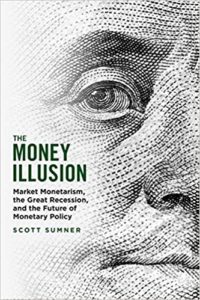If I Were a Market Monetarist
By Arnold Kling


- The central problem in monetary policy is that the variables that a central bank can easily control on a day-to-day basis, such as the fed-funds rate, the monetary base, and the price of gold, do not reliably correlate with the things we care about, such as the CPI, unemployment, and nominal GDP.
- –Scott Sumner, The Money Illusion, p. 199.1
The latest monetary treatise is Scott Sumner’s The Money Illusion. In his book, he attempts to tackle the usual problems of explaining how changes in monetary policy affect prices, interest rates, and employment.
Four Thought-experiments
Sumner carefully distinguishes four effects of money on interest rates. He calls these: the price-level effect; the liquidity effect; the income effect; and the Fisher effect. Each can be illustrated with a different thought-experiment involving a monetary “expansion.”
For example, consider the classic Helicopter Drop, a one-time injection of more money into the economy. If the government doubles the money supply by dropping dollar bills from a helicopter, then this should eventually double the level of prices. Suppose that prices adjust right away, so that we reach the new equilibrium right away. In that case, the interest rates stay the same. The price-level effect is zero.
But if prices are sticky in the short run, the helicopter drop causes a decrease in interest rates, due to the liquidity effect. Think of this as a drop in borrowing because people have more money than they need relative to those sticky prices. Only after prices have adjusted do we arrive at the equilibrium in which interest rates return to previous levels.
Suppose we try a different thought-experiment. Instead of a one-time injection of money, consider an increase in the rate of money growth. This will lead to an increase in inflation. In order to maintain the inflation-adjusted value of assets, savers will require higher interest rates. The result is the Fisher effect—the higher the rate of inflation, the higher are nominal interest rates. Faster money growth would tend to increase interest rates.
As another thought-experiment, suppose that the Fed surprises the public by raising the rate of money growth. Because inflation does not immediately adjust upward, there is an economic boom, and with the boom there is an increase in interest rates. I won’t go into the reason for the boom, but an explanation can be found in Sumner’s book and elsewhere.
The bottom line is that “loose” money can result in no change in interest rates, a decrease in interest rates, or an increase in interest rates, depending on which thought-experiment we are conducting.
Targets, Indicators, and Instruments
In 1975, Benjamin Friedman (no relation to Milton Friedman), published an article that sought to clarify the difference between the targets of monetary policy, the indicators of monetary policy, and the instruments of monetary policy.2 A target is a variable for which the monetary authority has a desired value. In the United States, the Fed could have a desired value for the unemployment rate or for the Consumer Price Index, for example. An indicator is a variable that the Fed can use to anticipate how close it is coming to its target. An instrument is what the Fed actually does to try to move the economy toward its target. The classic textbook instruments when I was studying economics were the discount rate (the rate that the Fed charges member banks to borrow funds), the reserve requirement (the fraction of deposits that banks must hold as reserves), and open market operations, which are purchases or sales of securities by the Fed.
Market monetarism, as I understand it, is the view that:
- (a) the appropriate target for monetary policy is a level of total spending (nominal GDP or NGDP) one year from now (say) that is in line with the long-term trend that the public has come to expect.
- (b) the appropriate indicator for monetary policy is the forecast for NGDP one year from now (say) as given by financial markets. If this indicator suggests that NGDP will come in below target, then the Fed should use one of its instruments in an expansionary way, and conversely.
- (c) the preferred instrument for monetary policy should be open market operations. Note that if interest rates on short-term government bonds drop to zero, open market operations can shift toward buying long-term bonds, private securities, or foreign exchange.
This is not too different from the way that the Fed operated when I was an economist there, in the early 1980s. The difference is that the indicator that the Fed used was known as the Greenbook Forecast for NGDP and other macroeconomic variables. The forecast always was enclosed in a green cover, and it was highly confidential.
The Greenbook Forecast was nominally a forecast from the Fed staff. I was nominally in charge of it at least three or four times. But I can tell you that my role, and that of the staff in general, was purely clerical. Our job was to produce the forecast that the Fed Chairman wanted to see inside that green cover. The Chairmen when I was at the Fed were Paul Volcker and then Alan Greenspan. Volcker at times appeared to delegate the supervision of the Greenbook forecast to Lyle Gramley, a former staffer who had been appointed one of the Fed governors.
I recall one lunch late in 1982 when Governor Gramley sat down at a table in the staff dining room with some of us. This was almost a shocking breach of protocol, because the governors had their own executive dining room, and on no other occasion did I see a Governor eat in the staff dining room. But Governor Gramley wanted to tell us that our forecast was too conservative because, in his words, “When a recovery comes, it really comes.” Of course, we adjusted the forecast.
As far as I can tell, the only change that has taken place since then is that the Fed is now much more public about forecasts. Members of the Fed’s Open Market Committee are invited to make forecasts, and the public is given a window into those forecasts, albeit with a short lag.
This method of operation is known as discretionary monetary policy, because the Fed changes policy at the discretion of its top officials. Milton Friedman, John Taylor, and other leading monetarists of the late 20th century scorned discretionary policy. They argued that the Fed’s forecast was an unreliable indicator of future economic performance, and discretionary policies based on this unreliable indicator would produce volatile results. Friedman argued that a measure of the money supply was a more reliable indicator. Taylor proposed that a weighted average of the latest measures of unemployment and inflation could serve as a better indicator.
Market monetarism differs from late 20th century monetarism in that it takes us back to discretionary policy. But it differs from the way the Fed uses discretion in practice by proposing that the Fed use financial market indicators to make its forecast.
If I were a market monetarist, I would be trying to come up with an algorithm to forecast NGDP using indicators like stock prices, exchange rates, and the spread between the interest rates on normal bonds and inflation-indexed bonds. If we had such an algorithm, we could benchmark it against the more seat-of-the-pants forecast judgments that are currently made at the Fed.
But Sumner does not propose such an algorithm, and I found this disappointing. Instead, he gives examples of where stock price declines in 2007 and 2008 indicated to him that NGDP was going to be far below target. One example he goes into at great length is a stock market decline that took place on December 11, 2007.
- That’s when the Fed announced a disappointingly small rate cut (0.25%, from 4.50% to 4.25%). I could write a whole book on this decision, because it has vast implications for monetary theory. But let’s start with some basic data.
- … The Dow Jones Industrial Average immediately plunged by almost 1.5%, and ended the day almost 2.5% below the preannouncement level. (p. 251)
That is a significant decline, to be sure, but there have been much larger one-day declines in stock prices on other days. Sumner does not say, nor should he, that one-day stock price declines always indicate that NGDP is going to be below target. The vast majority of such declines were not followed by disappointing NGDP growth.
So how did Scott Sumner know that this particular stock price decline, as well as those that took place in the latter part of 2008, were an indication that NGDP as going to fall well short of its target? It seems to me that unless he can articulate his algorithm, Sumner’s version of market monetarism is impossible to operationalize. If seat-of-the pants analysis of the stock market is the way to forecast NGDP, then for all we know, members of the Federal Open Market Committee may have always been implementing market monetarism.
To get around the need to explain how to infer NGDP forecasts from financial markets, Sumner suggests using a futures market in NGDP itself. An NGDP futures market is essentially a betting market, in which individuals can go long when they have information that suggests that NGDP will turn out to be higher than the current “price” and go short when their information suggests the opposite.
Would an NGDP futures market provide a reliable guide for discretionary monetary policy? That seems like an empirical question. But my guess is that if NGDP can be accurately forecast by speculators, then the market NGDP forecast can already be extracted from the above-mentioned indicators.
An assertion that you made a better forecast of NGDP than the Fed did in 2007, even if that assertion is true, does not prove your case. If I were a market monetarist, articulating an NGDP forecasting algorithm derived from market indicators, and demonstrating its reliability through a variety of historical episodes, would be high on my research agenda.
Footnotes
[1] Scott Sumner, The Money Illusion: Market Monetarism, the Great Recession, and the Future of Monetary Policy. University of Chicago Press, 2021
[2] Benjamin Friedman, “Targets, Instruments and Indicators of Monetary Policy.” Journal of Monetary Economics. 1975.
*Arnold Kling has a Ph.D. in economics from the Massachusetts Institute of Technology. He is the author of several books, including Crisis of Abundance: Rethinking How We Pay for Health Care; Invisible Wealth: The Hidden Story of How Markets Work; Unchecked and Unbalanced: How the Discrepancy Between Knowledge and Power Caused the Financial Crisis and Threatens Democracy; and Specialization and Trade: A Re-introduction to Economics. He contributed to EconLog from January 2003 through August 2012.
Read more of what Arnold Kling’s been reading. For more book reviews and articles by Arnold Kling, see the Archive.
